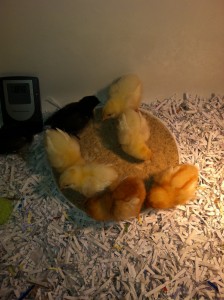Warmth - the first week make sure it’s 90-100 degrees, with 95 degrees being optimal, then you can reduce it by 5 degrees each week thereafter, while the chicks are feathering out (5-8 weeks old). Once you get to 70 degrees F, they should be fine on their own.
A thermometer in your bathtub-brooder is always a good idea. Everyone has one or two of these around. If you don’t have one immediately available, you can tell if the temperature is right by how the chicks are behaving. If they are panting or huddling in areas farthest from the light, they are too hot. If they huddle together in a ball under the light, they are too cold. The sounds of there noisy complaints will be deafening. You can adjust the distance of the light (or change the wattage of the bulb) until you have it just right. Click here to get an inexpensive Thermometer Humidity Gauge Combo Pak on Amazon
My 2 warming lights are hung on a separate tension- rod which I took from my other bathroom temporarily. (We have a separate shower stall for washing.) I bought a ceramic light socket with the heat resistant wires already attached. Make sure the socket is rated for the wattage of the heat lamp you will be using. And always, always be careful of using anything electrical in the bathroom or near water. Common sense safety. If there’s a way of shutting on and off your water valves for the bathtub, by all means shut them off. Some warming light options include: Brinsea EcoGlow Brooder for Chicks or Ducklings, Zoo Med Deluxe Porcelain Clamp Lamp with 10-Inch Dome, Black
I hang a 150Watt, infra-red heat bulb (this one) starting at about 18 inches above the top of the chickens back. Moving it 2 inches a week usually works for me. But you should adjust it to the right height using a thermometer. I like to measure the temperature directly under the light and the farthest corner from the light which should be cooler by ten or so degrees. If the chickens spread out evenly around the heat circle then you now its ideally right.
The Black bulb is used because these little peeps need to rest at night and bright lights continually, can make them go stir crazy. Feather picking will be the end result of that.
Most people buy warming lights from the pet store that come with a safety cover on the bottom of the light fixture. This is to prevent your babies from getting burned if the fixture should fall or they fly high enough to reach it. I personally think it’s a good idea to have this feature.
Warming lights are costly. But if you ask around you’ll be pleasantly surprised at how easy it is to find someone who will give you one they no longer use. My girlfriend’s son had lizards, at one time, and my cousin had snakes. My neighbor even had one for a tortoise his son had several years ago.
I have two lights, just in case one goes out my spare can be turned on, immediately. Baby chicks can’t regulate their body temperature yet and can chill easily and die. That is why you can’t buy just one chick. They always sell several together so they can snuggle close and keep each other warm for the trip home.
A common 100 Watt bulb won’t keep them warm enough so don’t waste your time. If it’s the only thing you have at the moment by all means use it and get a heat bulb immediately.
Remember, they need ventilation without drafts. The common household bathtub provides just that! It’s always optimal to prepare for your chicks arrivel by making sure the area where they are going is already warm.
Continue to Part 3: How to Feed Baby Chickens
Tags: baby chicks temperature, chickens, raising chickens, warm
[…] to Part 2: Raising Baby Chickens Temperature Share and […]